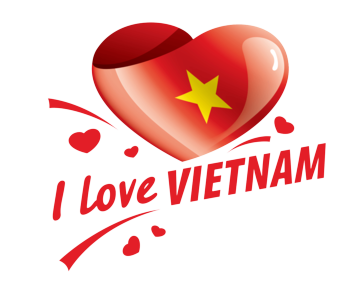You may have heard of the term “xe lôi” but what is a xe lôi? What does a xe lôi carry? Have you ever experienced riding a xe lôi in the Mekong Delta? It’s like sitting in a box with wheels and being pulled, quite an interesting experience, right?
What is a Xe Lôi?
Xe lôi can be understood as a regular vehicle with an additional part for carrying goods or people. This additional part is pulled or “lôi” by the vehicle’s own generated power. In the northern region, it may be called a pulling vehicle. So, in a way, a container truck can also be considered a type of xe lôi, “hehe”.
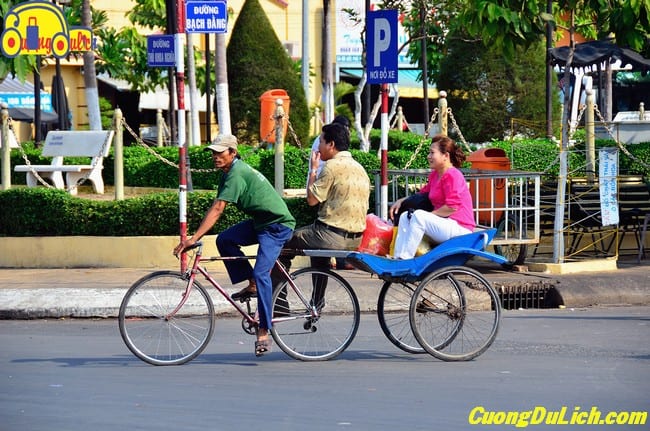
What Does a Xe Lôi Carry?
As mentioned above, xe lôi is a versatile vehicle designed to carry people or goods. Therefore, xe lôi can carry anything, such as:
- In rural mountainous areas, they often attach a wheeled cart to a motorcycle to transport goods, harvested flowers, etc.
- In cities, especially densely populated areas, vendors like vegetable or meat sellers convert their motorcycles into xe lôi for easier maneuvering.
- In the Mekong Delta, they convert bicycles into xe lôi to transport people, tourists.
Xe Lôi in the Mekong Delta
Here, I mainly refer to the type of xe lôi in the Mekong Delta – bicycles converted to carry tourists for sightseeing. It’s an attractive experience when traveling to the Mekong Delta. The feeling of leisurely admiring the scenery and enjoying the slow and peaceful pace of the locals is wonderful. The lightweight xe lôi moves gently, without the noise of engines. Occasionally, you hear the bell sound of the xe lôi rider asking for the way, which is quite delightful. The ting tong bell sound of the bicycle rider brings back childhood memories, the time of riding bikes for miles to school every day.
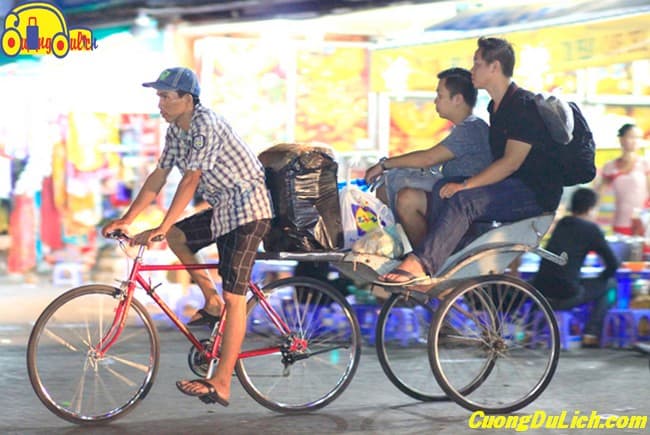
Origin of Xe Loi
Xe Loi is a type of vehicle widely used in Vietnam from the mid-20th century to the present. Xe Loi is a type of vehicle similar to a rickshaw, but the driver sits in the front and pedals the vehicle. In fact, it is still a homemade vehicle, so the first Xe Loi and its inventor have not been identified yet.
In the book “Chasing Rickshaws,” author Tony Wheeler writes that Xe Loi was present in Singapore in the 1920s. In the capital city of Dhaka, Bangladesh, Xe Loi flourished in the early 1940s, and there are still up to 400,000 operating in this densely populated urban area.
The appearance of Xe Loi in the early stages was seen as a more civilized form of transportation replacing the “human horse” pull carts. This type of vehicle could carry up to two people or heavy goods. In Vietnam, Xe Loi is associated with the colonial period of the French. Pedal Xe Loi was present everywhere in the southern provinces with even more in number in the mid-1940s.
Structure of Xe Loi
Xe Loi is designed based on the idea of improving the rickshaw. As it is not an industrial production vehicle, the shape and design of each Xe Loi vary. In many provinces, Xe Loi has a variety of box shapes. Some have small boxes, some have large boxes, some are long, and some are short. Pedal Xe Loi has a low box, a narrow box that can carry about two people. Some boxes are added with a thick wooden plank placed horizontally opposite to facilitate carrying goods for fruit and vegetable vendors or carrying additional people. Some boxes do not have a canopy, while others have a canvas cover for the back seat passenger, leaving the front seat passenger exposed to the sun and rain.
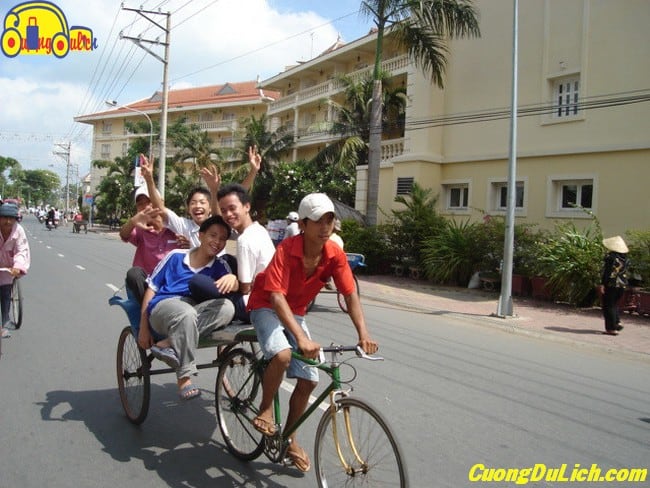
Motorized rickshaws carrying passengers in the western provinces
Motorized rickshaws in Soc Trang and Can Tho have similar box-shaped structures. The box resembles a cyclo, with a curved fabric canopy to shield passengers from the sun and rain, known as the “king’s rickshaw” carrying two people. Long-box rickshaws with a flat front can carry seven to eight people or goods commonly seen in the border areas of Tri Ton and Tinh Bien in An Giang province. Rickshaws are present in most southern provinces, but notably absent in the Ca Mau river and canal region where boats are the primary mode of transportation.
Perhaps due to the increasing number of motorbikes in each household, the use of rickshaws as a means of transport has decreased. Furthermore, more modern means of transportation such as taxis are becoming popular, causing rickshaws to become a beloved memory of the past.
The expansion of the box structure was mainly for accommodating more passengers in motorized rickshaws. Since the 1950s, German motorbikes like Goebel and Puch were used to power rickshaws and even pedal tricycles were converted into motorized tricycles for faster and more efficient transportation of goods. Later, Japanese Honda motorbikes were also used to power motorized rickshaws.
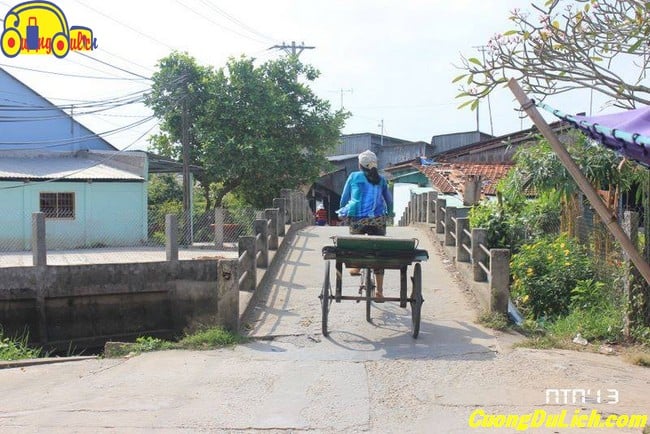
In the provinces of the Mekong Delta in Southern Vietnam, the traditional “xe lôi” has a basket similar to a cyclo, with a curved fabric canopy to protect passengers from the sun and rain, known as the “king’s vehicle” carrying two people. The longer basket xe lôi can carry seven to eight people or goods.
Types of Xe Lôi in Vietnam
We can mention some common types of xe lôi in Vietnam today:
Xe lôi in the Mekong Delta:
Consists of a bicycle with a simple basket attached, very useful for carrying both people and bulky items.
Children’s Xe Lôi:
A compact, sturdy, and safe design for children, with a strong frame and LED lights on the sides and front of the bike.
Three-Wheeled Xe Lôi:
Similar to a homemade three-wheeled vehicle, with a front part (motorcycle) and a cargo-carrying part, capable of carrying 300 – 450 kg. Overall, this type of xe lôi is considered a variant of the banned list.
Experience Riding Xe Lôi in the Mekong Delta
Previously, xe lôi used to transport passengers throughout the Mekong Delta, but now it is only found in Chau Doc City, An Giang Province. The xe lôi has a bicycle front similar to the Thong Nhat bicycle, with an added passenger-carrying part at the back with two wobbly wheels. A xe lôi can carry up to 4 passengers. To reduce weight and ensure safety, most modern xe lôi bikes have gear shifts to adjust speed and torque while pedaling.
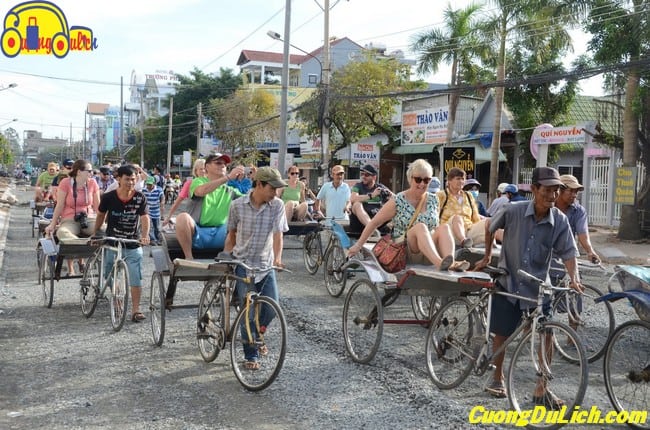
For about 100,000 VND, a two-person ride lasting about 45 minutes on a rickshaw will take passengers around Chau Doc. The rickshaw will take tourists to various notable spots in the city, including:
- Mr. Thoai Ngoc Hau’s ancestral temple – the person who directed the digging of the Vinh Te canal connecting from the source of the Hau River to Ha Tien, parallel to the Vietnam – Cambodia border
- The monument of the three-striped catfish in the 30-4 park, marking the species that has transformed many lives in An Giang province and the Mekong Delta in general
- The Bodhi tree sapling taken from the Bodhi tree under which Buddha meditated and attained enlightenment in the city center since 1952
- Famous snack spots in the southwestern border city of the country.
In the southwestern region near Tet holidays, we may come across wedding processions on rickshaws, looking very charming, carrying the soulful essence of the people in this region. If you visit the southwestern region, don’t miss the opportunity to experience riding a rickshaw.
